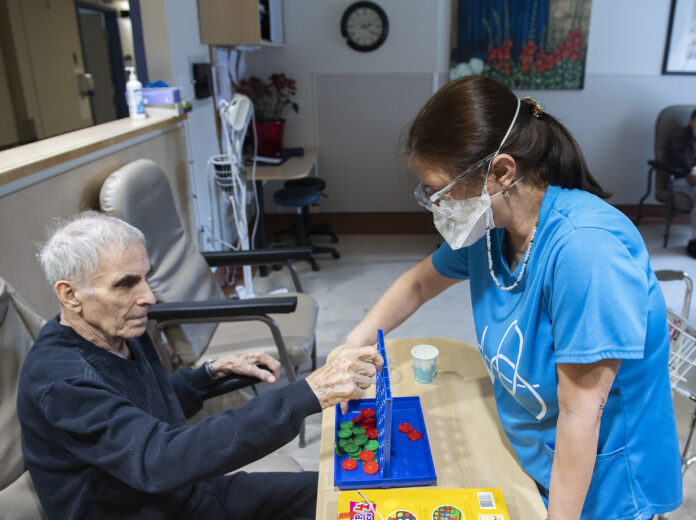Live music has returned to the halls of the Idola St-Jean long-term care home.
Snow swirled outside the windows of the Laval, Que., residence on a recent afternoon, as a singer, wearing a surgical mask and plastic eye goggles, launched into a version of Billy Joel’s “Just the Way You Are.” While most of her audience of four or five residents in wheelchairs ignored her — more occupied with dolls or a game — one woman smiled broadly, closing her eyes as she listened to the music.
For much of the COVID-19 pandemic, scenes like this did not exist inside Quebec’s long-term care homes.
A year ago, Idola St-Jean was in the throes of a major COVID-19 outbreak, with dozens of workers and residents infected. Most activities were cancelled, and the Billy Joel singer — who normally is a recreation co-ordinator — was reassigned to a job in infection control.
Now, life in the long-term care home north of Montreal is slowly returning to normal, despite the continued presence of COVID-19.
Dr. Olivier Haeck, who is in charge of infection control for the Laval health authority, says the combination of high vaccination rates among long-term care residents and the prevalence of a less severe strain of the novel coronavirus has made easing restrictions possible.
In a recent interview, he said the mortality rate in the fifth wave appears to be about 10 times less than in the first.
“(In earlier waves) there was no question of easing restrictions; it was clear,” Haeck said.
“Now, we saw people weren’t so sick — they had maybe a small cold, maybe no symptoms at all.”
Véronique Boulanger, a nurse and infection control specialist, adds that Idola St-Jean has had two deaths in the fifth wave of COVID-19 out of 62 patients. During earlier outbreaks, nearly 50 per cent of residents who were infected died.
COVID-19 update: Where does Quebec stand in fight against virus?
Close contacts of positive cases are generally asked to isolate for 10 days, but they can be allowed to leave their rooms after five if they agree to social distancing. In early waves, when a negative PCR test was required, some residents stayed isolated for weeks. Distant contacts, meanwhile, aren’t tested unless they develop symptoms.
Trending Stories
Russian billionaires moving superyachts to Maldives as sanctions tighten
Ruble in trouble: Russian currency plummets amid Ukraine war sanctions
The Canadian Press was allowed to visit Idola St-Jean — including two wards with COVID-19-positive patients. During a guided visit of the facility, Boulanger explained that the health authority is working to find a balance between infection control and quality of life.
Most of the residents don’t wear masks, she said, but staff wear N95s, eye protection and, on COVID-19 wards, gowns.
In one COVID-19 wing, residents with the disease stayed in their rooms — but with doors open. One man, identified by a sign outside the door as COVID-19 positive, sat at a table colouring, apparently unbothered by the virus.
READ MORE: COVID-19: Quebec to end most mask requirements in April, stop vaccine passport sooner
Another COVID-positive wing, with five cases, housed patients with cognitive impairments who wander. While it’s almost impossible to get this clientele to follow health rules, Boulanger said that in earlier waves, security guards and volunteers were posted outside rooms to try to encourage residents to stay in place. Today, that’s no longer the case.
Boulanger said the long-term care home added a team of coaches who spend time with staff to field questions, lead exercises, and work with visitors and workers one-on-one. Many of these workers, Boulanger explained, are people whose jobs were halted by the pandemic: nutritionists, activity co-ordinators and librarians.
While the Omicron wave didn’t lead to the same level of restrictions as the previous ones, it has nevertheless led to hardship.
Lise Métras is a survivor, having already had COVID-19 at least twice. Her latest bout, in recent weeks, robbed her of her walks in the corridor and visits from her four children. “Now, I’ve started to walk; my daughter came to visit and my son came, but I find it hard,” the 81-year-old said.
“But it’s not only here. There are a lot of places where it’s like that, and it’s for us, for our safety.”
Métras, who wore a striped shirt and sported bright pink fingernails, agreed that more activities are available now than in previous waves. But she said she isn’t interested in socializing or classes. What she wants is to be able to visit family.
Nowadays, it’s the weather, not the rules, that prevents her. “There’s always something,” she said. “I find it very hard.”
Gisèle Lamarche, 94, lives on a COVID-19-free ward. She didn’t find life in the home too hard during the pandemic, but she said things are more lively now with the presence of more people who lead activities like knitting and bingo.
But like for Métras, a return to normal means getting out with family, and for that she needs to wait for warmer weather.
“I have four sons, and they push me in my wheelchair and bring me to the park to see the greenery and the little ducks,” she said. “It will be nice to get fresh air.”
© 2022 The Canadian Press



